Located almost 7,000 feet above the Pacific Ocean in the San Bernardino Mountains and just two hours from Los Angeles, Big Bear Valley offers some of the most beautiful scenery in Southern California.
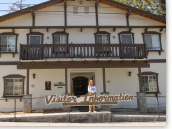 The Valley is comprised of Big Bear Lake, Big Bear City, Fawnskin, Holcomb Valley, Sugarloaf, Erwin Lake, Baldwin Lake and Lake Williams. It was first occupied by the Serrano Indians, who first came to Yuhaviat or pine place approximately 3,000 years ago. The Indians called themselves Yuharetum, which means people of the pines, but the Spanish gave them the name Serrano, which is Spanish for people of the mountains. They were a peaceful and gentle people who lived in small settlements of 10 to 30 dwellings near springs, streams and rivers. Their dwellings were circular buildings that measured twelve to fourteen feet across and were constructed within an excavated area as much as two feet deep. A fire-pit lined with stones was dug in the center of each dwelling. The Serrano were regarded as skilled basket weavers, and the women were expert pottery makers. Their diet included pinon nuts, berries, roots, tubers, bulbs and sage; acorn mush was a basic food. The Serrano held the grizzly bear in deep reverence, and bear meat was never eaten nor was bear fur ever worn. Their settlements are remembered today in town names such as Yucaipa, Cucamonga and Muscupiabe.
The Valley is comprised of Big Bear Lake, Big Bear City, Fawnskin, Holcomb Valley, Sugarloaf, Erwin Lake, Baldwin Lake and Lake Williams. It was first occupied by the Serrano Indians, who first came to Yuhaviat or pine place approximately 3,000 years ago. The Indians called themselves Yuharetum, which means people of the pines, but the Spanish gave them the name Serrano, which is Spanish for people of the mountains. They were a peaceful and gentle people who lived in small settlements of 10 to 30 dwellings near springs, streams and rivers. Their dwellings were circular buildings that measured twelve to fourteen feet across and were constructed within an excavated area as much as two feet deep. A fire-pit lined with stones was dug in the center of each dwelling. The Serrano were regarded as skilled basket weavers, and the women were expert pottery makers. Their diet included pinon nuts, berries, roots, tubers, bulbs and sage; acorn mush was a basic food. The Serrano held the grizzly bear in deep reverence, and bear meat was never eaten nor was bear fur ever worn. Their settlements are remembered today in town names such as Yucaipa, Cucamonga and Muscupiabe.
In 1810, a semi-retired Franciscan priest, Padre Dumetz from the San Gabriel Mission near Los Angeles, built a small chapel to celebrate mass in a nearby mission Indian village he was visiting.
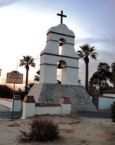 Because he completed the chapel on or near the feast day of Saint Bernard of Siena, Padre Dumetz named the area San Bernardino. The name would later identify the valley, the city, the mountain range, a national forest, and the largest county in the contiguous United States. The need for pastures and farmland in the area led to the establishment of Rancho San Bernardino in nearby present-day Redlands. Slowly the Valley saw the increasing presence of white men. Mexico secured its independence from Spain in 1821, and hundreds of trailblazers continued to arrive in Alta California. In 1833, mission properties were confiscated from the Church and placed under government-appointed administrators.
Because he completed the chapel on or near the feast day of Saint Bernard of Siena, Padre Dumetz named the area San Bernardino. The name would later identify the valley, the city, the mountain range, a national forest, and the largest county in the contiguous United States. The need for pastures and farmland in the area led to the establishment of Rancho San Bernardino in nearby present-day Redlands. Slowly the Valley saw the increasing presence of white men. Mexico secured its independence from Spain in 1821, and hundreds of trailblazers continued to arrive in Alta California. In 1833, mission properties were confiscated from the Church and placed under government-appointed administrators.
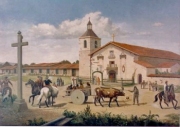 During this secularization of the missions, the Mexican government began transferring title of the Franciscan dynasty to influential, political, and military figures. Mission lands were given to members of the Spanish gentry, such as the Lugos, Bandinis, Picos, and Sepulvedas. These family names would later become familiar throughout California. Antonio Lugo, who acquired the former Rancho San Bernardino, was one of several wealthy landowners who also capitalized on the timber economy provided by the nearby mountains. Two of the first non-Hispanic land grantees were Benjamin Wilson and Isaac Williams. Daniel Sexton, a logger and an employee of Williams, operated one of the mountain's first sawmills located in the San Gorgonio Pass.
During this secularization of the missions, the Mexican government began transferring title of the Franciscan dynasty to influential, political, and military figures. Mission lands were given to members of the Spanish gentry, such as the Lugos, Bandinis, Picos, and Sepulvedas. These family names would later become familiar throughout California. Antonio Lugo, who acquired the former Rancho San Bernardino, was one of several wealthy landowners who also capitalized on the timber economy provided by the nearby mountains. Two of the first non-Hispanic land grantees were Benjamin Wilson and Isaac Williams. Daniel Sexton, a logger and an employee of Williams, operated one of the mountain's first sawmills located in the San Gorgonio Pass.
As more Mexican and American traders moved into Southern California, the number of horses and mules also increased, which in turn led to an escalation in horse stealing and Indian raids. In order to restore law and order, the
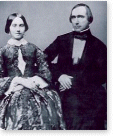 Mexican Governor of California, Pio Pico, commissioned Benjamin (Benito) Wilson as Justice of the Peace for the Inland Territory. Wilson, a former fur trapper and Indian trader, became one of the first American settlers in Southern California. A naturalized Mexican citizen, his first extensive land acquisition was the purchase of Rancho Jurupa, located in present-day Riverside. He then married Ramona Yorba, whose family owned property that included the 78,941 acre Rancho Santiago de Santa Ana. After Ramona's death, he married Margaret Hereford of Los Angeles and became a prosperous rancher and later one of the first land sub-dividers. At one time Wilson owned lands that would eventually become Westwood, Pasadena, Alhambra, San Gabriel, Riverside and San Bernardino.
Mexican Governor of California, Pio Pico, commissioned Benjamin (Benito) Wilson as Justice of the Peace for the Inland Territory. Wilson, a former fur trapper and Indian trader, became one of the first American settlers in Southern California. A naturalized Mexican citizen, his first extensive land acquisition was the purchase of Rancho Jurupa, located in present-day Riverside. He then married Ramona Yorba, whose family owned property that included the 78,941 acre Rancho Santiago de Santa Ana. After Ramona's death, he married Margaret Hereford of Los Angeles and became a prosperous rancher and later one of the first land sub-dividers. At one time Wilson owned lands that would eventually become Westwood, Pasadena, Alhambra, San Gabriel, Riverside and San Bernardino.
In 1845, a fierce, young Ute Indian Chief named Walkara, leading a group of renegade horse thieves and rustlers, stole a large herd of Antonio Lugo's cattle, and drove them off into the desert. Benjamin Wilson, as Justice of the Peace for the Inland Territory, led a posse of New Mexicans and Californios in pursuit of Walkara. Wilson sent half of the men through the Cajon Pass, and he led the other half into San Bernardino's Santa Ana Canyon. Climbing higher and higher over rough terrain and steep granite ridges, his party came across an alkali lake and a small Indian settlement surrounded by forests of tall Ponderosa, Jeffrey, and Lodgepole pines. Even though Wilson's group did not find Walkara, what they did find was an ancient and mysterious forest teeming with grizzly bears.
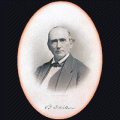 It is reported that Wilson and his men took eleven huge bear pelts with them that day. Word of their adventure spread throughout the territory, and before long the area which is now known as Big Bear and Big Bear Lake was named "Bear Valley."
It is reported that Wilson and his men took eleven huge bear pelts with them that day. Word of their adventure spread throughout the territory, and before long the area which is now known as Big Bear and Big Bear Lake was named "Bear Valley."
Elected mayor of Los Angeles in 1851, Benjamin Wilson was a key figure in convincing the Southern Pacific Railroad to pass through Los Angeles rather than around it. He also became a friend to the Indians, and in 1852 was appointed their subagent. As a subagent, Wilson was instrumental in creating the reservation system and establishing policies to help provide for the future welfare of Indians afflicted by the breakdown of the old mission program (see San Fernando Mission). Before his death in 1878, Benjamin Wilson also served as Los Angeles County Supervisor and was elected to three terms in the California State Senate. Today, Mount Wilson in the San Gabriel Mountains bears his name.
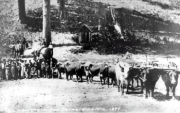 Logging in the San Bernardino Mountains dates back to 1851 when a wagon train of 500 Mormons from Salt Lake City arrived at the base of these mountains below what is now Crestline. A small community was established, which they called San Bernardino. The settlers began cutting the much needed lumber by hand, fashioning a road up the steep Waterman Canyon and establishing the first sawmill in the San Bernardino Mountains. The rapid growth of San Bernardino and nearby Los Angeles created an unlimited demand for lumber,
Logging in the San Bernardino Mountains dates back to 1851 when a wagon train of 500 Mormons from Salt Lake City arrived at the base of these mountains below what is now Crestline. A small community was established, which they called San Bernardino. The settlers began cutting the much needed lumber by hand, fashioning a road up the steep Waterman Canyon and establishing the first sawmill in the San Bernardino Mountains. The rapid growth of San Bernardino and nearby Los Angeles created an unlimited demand for lumber,
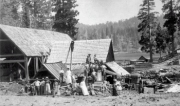 and new sawmills quickly spread eastward across the mountaintops towards Little Bear Valley, which is now Lake Arrowhead. In 1867, Francis L. Talmadge built one of the area's largest mills down in the meadows of Little Bear Valley. By the early 1880s, Talmadge, along with several other operators including La Praix, Caley, and the Tyler brothers were hauling a combined total of four to six million board feet of lumber out of the San Bernardino Mountains each year.
and new sawmills quickly spread eastward across the mountaintops towards Little Bear Valley, which is now Lake Arrowhead. In 1867, Francis L. Talmadge built one of the area's largest mills down in the meadows of Little Bear Valley. By the early 1880s, Talmadge, along with several other operators including La Praix, Caley, and the Tyler brothers were hauling a combined total of four to six million board feet of lumber out of the San Bernardino Mountains each year.
In 1899, a Michigan-based corporation headed by John E. Brookings purchased all of the holdings of the Highland Lumber Company, which operated near Running Springs. Soon Brookings began turning this new acquisition into the largest and most controversial operation in these mountains.
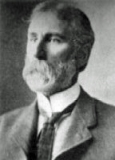 A railroad was built to haul cut logs to the mill, and locomotives and flat cars were dragged up the newly built City Creek Toll Road, now Highway 330, all the way to the mill. The Brookings Lumber Company acquired lumber rights to over 6,000 acres of mountain timber, and between 1901 and 1911 delivered approximately 10 million board feet of lumber each year.
Consequently, the unregulated, clear-cut logging method of the time completely stripped the watershed from large areas of the mountains. In one of the earliest conservation movements, San Bernardino Valley residents successfully petitioned President Theodore Roosevelt to expand upon former President Harrison's Forest Reserve Act of 1891 to encompass and thus save all remaining privately held timberland in the San Bernardino Mountains. This action effectively forced replanting the areas that had been clear-cut. The Forest Service then stepped in, increased its control, and established new regulations. Annoyed with the new regulations, the Brookings Lumber Company dismantled their operations and moved to Oregon in 1912.
The withdrawal of the Brookings Company marked the end of large scale lumbering in the San Bernardino Mountains. The Arrowhead and Running Springs forests of Big Bear Valley were saved from future unscrupulous logging and, unlike the forests of other mountain ranges, were spared from being denuded. San Bernardino County would eventually take over the Brookings
railroad right-of-way and turn it into part of the Rim-of-the-World Drive between Running Springs and Lake Arrowhead.
A railroad was built to haul cut logs to the mill, and locomotives and flat cars were dragged up the newly built City Creek Toll Road, now Highway 330, all the way to the mill. The Brookings Lumber Company acquired lumber rights to over 6,000 acres of mountain timber, and between 1901 and 1911 delivered approximately 10 million board feet of lumber each year.
Consequently, the unregulated, clear-cut logging method of the time completely stripped the watershed from large areas of the mountains. In one of the earliest conservation movements, San Bernardino Valley residents successfully petitioned President Theodore Roosevelt to expand upon former President Harrison's Forest Reserve Act of 1891 to encompass and thus save all remaining privately held timberland in the San Bernardino Mountains. This action effectively forced replanting the areas that had been clear-cut. The Forest Service then stepped in, increased its control, and established new regulations. Annoyed with the new regulations, the Brookings Lumber Company dismantled their operations and moved to Oregon in 1912.
The withdrawal of the Brookings Company marked the end of large scale lumbering in the San Bernardino Mountains. The Arrowhead and Running Springs forests of Big Bear Valley were saved from future unscrupulous logging and, unlike the forests of other mountain ranges, were spared from being denuded. San Bernardino County would eventually take over the Brookings
railroad right-of-way and turn it into part of the Rim-of-the-World Drive between Running Springs and Lake Arrowhead.
At about the same time that the logging industry was taking off on the west end of the San Bernardino Mountains, a gold rush was starting on the east end near Big Bear Lake.
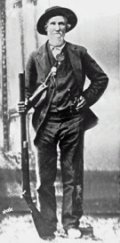 After ten years of unsuccessful prospecting and mining in Northern California and Oregon, Bill Holcomb and his partner Jack Martin came to Bear Valley in the winter of 1859. When their hard work in Bear Valley only yielded a modest strike, Martin returned to Los Angeles to get his family. In the meantime, while hunting bear in late April 1860, Holcomb crossed the meadow in the center of Bear Valley, climbed up the west side of Bertha Peak, and saw what he described as "the most beautiful mountain valley I have ever seen." A few days later, Holcomb and his companions returned to the Valley and while tracking a grizzly along what is now Caribou Creek, Bill noticed glittering specks of gold in a quartz ledge. News of his exciting discovery spread swiftly. Before long, droves of prospectors invaded what eventually became known as Holcomb Valley, staking and working their own claims. Over the next several months, settlements such as Belleville, Clapboard Town, and Union Town sprung up throughout Holcomb Valley. Soon the Valley's population swelled to over 2,000, and residents here outnumbered the rest of San Bernardino County. Buildings and businesses sprung up everywhere, including a general store, saloon, grocery store, blacksmith shop and the famous Octagon House, where the glitter girls danced and otherwise entertained men in small, dimly lit cubicles. As the number of prospectors flocked to Bear Valley in the hunt for gold and silver ore, the Bear Valley Mining District was founded. Within a year, however, it became apparent that placer mining was not very profitable and the "gold fever" began to subside. By the end of the second year, most miners had given up their claims.
After ten years of unsuccessful prospecting and mining in Northern California and Oregon, Bill Holcomb and his partner Jack Martin came to Bear Valley in the winter of 1859. When their hard work in Bear Valley only yielded a modest strike, Martin returned to Los Angeles to get his family. In the meantime, while hunting bear in late April 1860, Holcomb crossed the meadow in the center of Bear Valley, climbed up the west side of Bertha Peak, and saw what he described as "the most beautiful mountain valley I have ever seen." A few days later, Holcomb and his companions returned to the Valley and while tracking a grizzly along what is now Caribou Creek, Bill noticed glittering specks of gold in a quartz ledge. News of his exciting discovery spread swiftly. Before long, droves of prospectors invaded what eventually became known as Holcomb Valley, staking and working their own claims. Over the next several months, settlements such as Belleville, Clapboard Town, and Union Town sprung up throughout Holcomb Valley. Soon the Valley's population swelled to over 2,000, and residents here outnumbered the rest of San Bernardino County. Buildings and businesses sprung up everywhere, including a general store, saloon, grocery store, blacksmith shop and the famous Octagon House, where the glitter girls danced and otherwise entertained men in small, dimly lit cubicles. As the number of prospectors flocked to Bear Valley in the hunt for gold and silver ore, the Bear Valley Mining District was founded. Within a year, however, it became apparent that placer mining was not very profitable and the "gold fever" began to subside. By the end of the second year, most miners had given up their claims.
A second gold rush commenced in 1874 when San Francisco multimillionaire Elias J. "Lucky" Baldwin (see also Los Angeles County Arboretum) constructed a large 40-stamp mill at the base of Gold Mountain.
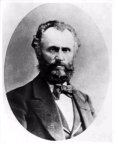 Stamp mills crushed ore to powder with heavy stamps, or pestles, and by the time Baldwin's stamp mill was fully operational in March of 1875, a new mining town, Bairdstown, with two saloons, a butcher shop, and two boarding houses had sprung into existence at the northeast end of Baldwin Lake. Unfortunately, the amount of gold recovered from Gold Mountain fell way below expectations, and after only seven months "Lucky" had to shut down his mill. Bairdstown quickly became a ghost town. The stamp mill sat idle until August of 1876, when it mysteriously caught fire and burned to the ground. "Lucky" Baldwin's second chance at success with a stamp mill came twenty-three years later in 1899, when Captain J.R. DeLaMar struck a deal with him to build a new 40-stamp mill on the hill above the original site. DeLaMar wanted to use a new cyanide process that would dramatically increase the yield of gold recovered from the low grade ore. By September 1900, the new stamp mill was running at full capacity, but only recovering a modest profit of $4,000 a week. Discouraged, DeLaMar shut down the mill in 1903.
Stamp mills crushed ore to powder with heavy stamps, or pestles, and by the time Baldwin's stamp mill was fully operational in March of 1875, a new mining town, Bairdstown, with two saloons, a butcher shop, and two boarding houses had sprung into existence at the northeast end of Baldwin Lake. Unfortunately, the amount of gold recovered from Gold Mountain fell way below expectations, and after only seven months "Lucky" had to shut down his mill. Bairdstown quickly became a ghost town. The stamp mill sat idle until August of 1876, when it mysteriously caught fire and burned to the ground. "Lucky" Baldwin's second chance at success with a stamp mill came twenty-three years later in 1899, when Captain J.R. DeLaMar struck a deal with him to build a new 40-stamp mill on the hill above the original site. DeLaMar wanted to use a new cyanide process that would dramatically increase the yield of gold recovered from the low grade ore. By September 1900, the new stamp mill was running at full capacity, but only recovering a modest profit of $4,000 a week. Discouraged, DeLaMar shut down the mill in 1903.
Road accessibility into Big Bear Valley initially grew out of necessity for the logging industry and later as a result of increasing tourism. One of the first routes into Big Bear Valley was a difficult trudge via the Santa Ana Canyon.
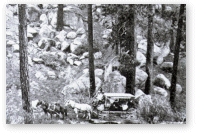 In June of 1861, Jed Van Dusen opened a wagon trail down the back side through Hesperia and the Cajon Pass to San Bernardino. By May 1892, the Bear Valley Wagon Road was opened from Hunsaker Flat (Running Springs) to Fawnskin via Green Valley, and in 1899 Gus Knight and Hiram Clark (Clark Grade Road) built the Bear Valley and Redlands Toll Road via the Santa Ana Canyon past Bluff Lake. The gold rush had brought civilization to the territory, and from 1861 until 1892 the communities of the San Bernardino Mountains were served regularly by horse-drawn stages. This exciting trek, on open stages with daredevil drivers and their adventure-seeking passengers, wound along rough dirt trails through pine forests and grizzly bear country, and took two days to reach the Big Bear Valley from San Bernardino.
In June of 1861, Jed Van Dusen opened a wagon trail down the back side through Hesperia and the Cajon Pass to San Bernardino. By May 1892, the Bear Valley Wagon Road was opened from Hunsaker Flat (Running Springs) to Fawnskin via Green Valley, and in 1899 Gus Knight and Hiram Clark (Clark Grade Road) built the Bear Valley and Redlands Toll Road via the Santa Ana Canyon past Bluff Lake. The gold rush had brought civilization to the territory, and from 1861 until 1892 the communities of the San Bernardino Mountains were served regularly by horse-drawn stages. This exciting trek, on open stages with daredevil drivers and their adventure-seeking passengers, wound along rough dirt trails through pine forests and grizzly bear country, and took two days to reach the Big Bear Valley from San Bernardino.
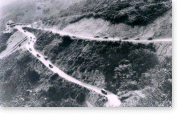 By the turn of the century, the mighty grizzly bear, so revered by the Serrano Indians, had been almost wiped out, and the last known grizzly in the San Bernardino Mountains was killed in 1906. Also, with the dawn of the iron horse, the colorful era of horse-drawn stages was fast coming to an end. While visiting New York, a young Californian named Kirk Phillips had seen a white truck with bench seats carrying passengers on Fifth Avenue. It was the world's first bus line. Believing that these buses would work well in the mountains, he established the famous Mountain Auto Line, and by the spring of 1912 was bringing freight and passengers to the mountains by motor power. These four-cylinder buses had open tops and sides, four rows of seats directly behind the driver, and room for thirteen passengers. By 1914, there were nine reliable white buses making the trip to and from the mountains. The bus route to Big Bear Valley was via the Mill Creek Road, which ran past the picturesque Bluff Lake and meadow area, and came out through the control gate opposite the historic Oak Knoll Lodge. During the 1920s, there were three main roads into Big Bear Valley: the Mill Creek and Johnson Grade Roads on the
By the turn of the century, the mighty grizzly bear, so revered by the Serrano Indians, had been almost wiped out, and the last known grizzly in the San Bernardino Mountains was killed in 1906. Also, with the dawn of the iron horse, the colorful era of horse-drawn stages was fast coming to an end. While visiting New York, a young Californian named Kirk Phillips had seen a white truck with bench seats carrying passengers on Fifth Avenue. It was the world's first bus line. Believing that these buses would work well in the mountains, he established the famous Mountain Auto Line, and by the spring of 1912 was bringing freight and passengers to the mountains by motor power. These four-cylinder buses had open tops and sides, four rows of seats directly behind the driver, and room for thirteen passengers. By 1914, there were nine reliable white buses making the trip to and from the mountains. The bus route to Big Bear Valley was via the Mill Creek Road, which ran past the picturesque Bluff Lake and meadow area, and came out through the control gate opposite the historic Oak Knoll Lodge. During the 1920s, there were three main roads into Big Bear Valley: the Mill Creek and Johnson Grade Roads on the
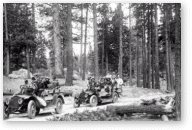 east end of the valley went past Baldwin Lake and down to Lucerne Valley; and City Creek and Waterman Canyon Roads came together at Running Springs, and continued onto Green Valley up the back side coming out at Fawnskin. The faster and cheaper mode of transportation vastly changed the mountain communities. Villages grew and resorts opened as Southern California's
major mountain recreation land was established.
east end of the valley went past Baldwin Lake and down to Lucerne Valley; and City Creek and Waterman Canyon Roads came together at Running Springs, and continued onto Green Valley up the back side coming out at Fawnskin. The faster and cheaper mode of transportation vastly changed the mountain communities. Villages grew and resorts opened as Southern California's
major mountain recreation land was established.
As the population of Big Bear Valley increased during the 1870s and 1880s, so did the need for more water. Frank E. Brown and Edward G. Judson were instrumental in developing a planned community that they called Redlands. Because water was needed for orange groves planted in the new community,
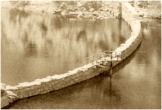 Dr. Benjamin Barton, a state assemblyman and pioneering physician, encouraged state engineers to consider Bear Valley as a site for a possible reservoir. Frank Brown raised money, purchased the lake site and created the Bear Valley Land and Water Company. A Yale graduate, Brown designed a single arch, granite ashlar (square-hewn stone) rock dam using cement from England. The granite blocks, weighing two to three tons each, were cut from the surrounding hillsides by hand, without the use of explosives. The dam was to be 52 feet high by 335 feet wide, and have a 20-foot wide spillway, four feet below the top. Although the winter snows of 1883 brought the construction of the dam to a halt, the work recommenced in June the following year. By November 1884, the dam reached its final height of 52 feet. When the workers went home for the winter, there was real concern as to whether the rock dam could hold back the enormous pressure of a five-mile lake; however, time would prove the dam impenetrable, its strength in the design and shape of its arch.
Dr. Benjamin Barton, a state assemblyman and pioneering physician, encouraged state engineers to consider Bear Valley as a site for a possible reservoir. Frank Brown raised money, purchased the lake site and created the Bear Valley Land and Water Company. A Yale graduate, Brown designed a single arch, granite ashlar (square-hewn stone) rock dam using cement from England. The granite blocks, weighing two to three tons each, were cut from the surrounding hillsides by hand, without the use of explosives. The dam was to be 52 feet high by 335 feet wide, and have a 20-foot wide spillway, four feet below the top. Although the winter snows of 1883 brought the construction of the dam to a halt, the work recommenced in June the following year. By November 1884, the dam reached its final height of 52 feet. When the workers went home for the winter, there was real concern as to whether the rock dam could hold back the enormous pressure of a five-mile lake; however, time would prove the dam impenetrable, its strength in the design and shape of its arch.
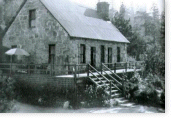 The following spring, Brown rode back into Big Bear Valley and was greeted by the sight of a new lake where lush green meadows and tall pine forests had stood one year earlier. The new Big Bear Lake had drowned over 9,000 trees. On July 10, 1885, the flood gates were opened and the water began flowing down Bear Creek to the Redlands' farmers. Frank Brown had created the largest man-made lake in the world at a cost of $75,000. The narrow "Rock Dam" was proven safe and would continue to hold strong for over 20 years. It still stands today, located approximately 50 yards east of the current dam, usually under about 20 feet of water. In October 1890, the historic Dam Keeper's House was built using hand-cut granite blocks from the same quarry that provided the stones for the dam.
The following spring, Brown rode back into Big Bear Valley and was greeted by the sight of a new lake where lush green meadows and tall pine forests had stood one year earlier. The new Big Bear Lake had drowned over 9,000 trees. On July 10, 1885, the flood gates were opened and the water began flowing down Bear Creek to the Redlands' farmers. Frank Brown had created the largest man-made lake in the world at a cost of $75,000. The narrow "Rock Dam" was proven safe and would continue to hold strong for over 20 years. It still stands today, located approximately 50 yards east of the current dam, usually under about 20 feet of water. In October 1890, the historic Dam Keeper's House was built using hand-cut granite blocks from the same quarry that provided the stones for the dam.
The nationwide financial collapse of 1893 dealt a serious blow to Bear Valley Land and Water, the company that built the Rock Dam. Financially overextended, the company was forced into bankruptcy and the fate and future of Big Bear Lake sat unresolved in the courts for the next decade. In June 1903,
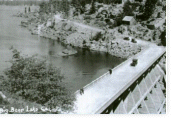 the Redlands-Highland area citrus growers, headed by Herbert H. Garstin, formed the Bear Valley Mutual Water Company. They paid off all the creditors and took over management of the dam, lake and other Big Bear Lake lands in 1909. Eventually, the dam could not hold enough water to meet its obligations, and it was decided to increase the holding capacity of the lake by raising the height of the dam. In April 1910, a new multiple-arch dam was designed by engineer John S. Eastwood. This new dam would be built about fifty yards downstream from the old Rock Dam. Unlike its predecessor, which had been constructed using materials found locally, all of the materials for the Eastwood Dam had to be transported from Victorville by wagon. A steam engine was hauled in and set up at the base of the Rock Dam to move the required tons of concrete and steel. Once the foundation was securely attached to the granite bedrock, construction was started on the massive buttresses that would bear the full weight of the lake. The dam was finished on schedule in 1912 at a cost of $138,000. At 72 feet high, Eastwood Dam was only 20 feet higher than the old Rock Dam, yet its holding capacity increased by three times. Once again, Big Bear Lake was the world's largest man-made lake.
the Redlands-Highland area citrus growers, headed by Herbert H. Garstin, formed the Bear Valley Mutual Water Company. They paid off all the creditors and took over management of the dam, lake and other Big Bear Lake lands in 1909. Eventually, the dam could not hold enough water to meet its obligations, and it was decided to increase the holding capacity of the lake by raising the height of the dam. In April 1910, a new multiple-arch dam was designed by engineer John S. Eastwood. This new dam would be built about fifty yards downstream from the old Rock Dam. Unlike its predecessor, which had been constructed using materials found locally, all of the materials for the Eastwood Dam had to be transported from Victorville by wagon. A steam engine was hauled in and set up at the base of the Rock Dam to move the required tons of concrete and steel. Once the foundation was securely attached to the granite bedrock, construction was started on the massive buttresses that would bear the full weight of the lake. The dam was finished on schedule in 1912 at a cost of $138,000. At 72 feet high, Eastwood Dam was only 20 feet higher than the old Rock Dam, yet its holding capacity increased by three times. Once again, Big Bear Lake was the world's largest man-made lake.
Eleven years after the completion of the Eastwood Dam, a bridge was added. San Bernardino then requested an easement across the top of the new dam for a new road along the south shore into Big Bear Village. The bridge and the new road cut travel time to the Village by almost an hour.
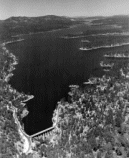 In the same year, the Deep Creek Cut-Off was also completed, and the picturesque cliff-hanging section of the road became known as the Arctic Circle. After nearly a century of operation, the Eastwood Dam has withstood earthquakes, floods and drastic temperature ranges from 30 degrees below zero to 100 degrees above zero. Likewise, during the same period of time, the Dam Keeper's House was home to over a dozen dam keepers and their families. The famed lumberjack Bill Knickerbocker and his family were early residents between 1909 and 1918. After the Municipal Water district purchased the lake in 1977, there was no longer a need for a resident dam keeper since the water would no longer be released for irrigation. Consequently, the water company returned the house to the Forest Service in the hope that it would become a museum. Unfortunately, that never came to pass, and today this historic building sits in an advanced state of deterioration and neglect. The roof and south facing wall have fallen down, some blocks have disappeared, and the inside walls and some of the rocks surrounding the house are covered with graffiti.
In the same year, the Deep Creek Cut-Off was also completed, and the picturesque cliff-hanging section of the road became known as the Arctic Circle. After nearly a century of operation, the Eastwood Dam has withstood earthquakes, floods and drastic temperature ranges from 30 degrees below zero to 100 degrees above zero. Likewise, during the same period of time, the Dam Keeper's House was home to over a dozen dam keepers and their families. The famed lumberjack Bill Knickerbocker and his family were early residents between 1909 and 1918. After the Municipal Water district purchased the lake in 1977, there was no longer a need for a resident dam keeper since the water would no longer be released for irrigation. Consequently, the water company returned the house to the Forest Service in the hope that it would become a museum. Unfortunately, that never came to pass, and today this historic building sits in an advanced state of deterioration and neglect. The roof and south facing wall have fallen down, some blocks have disappeared, and the inside walls and some of the rocks surrounding the house are covered with graffiti.
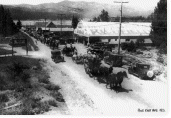 During the early part of the twentieth century, Big Bear became a magnet for vacationers and winter sports enthusiasts. Big Bear's first hotel had been built in 1888 by Gus Knight, Jr., a 21-year-old cattleman who had the foresight to recognize that the new lake would draw tourists to the area. Knight, along with his partner, John Metcalf, purchased 80 acres south of the lake, and in June opened the 30-guest, Bear Valley Hotel. Knight's hotel enjoyed a monopoly on Big Bear's tourist industry for the next twelve years. Unfortunately, on New Year's Eve 1900,
During the early part of the twentieth century, Big Bear became a magnet for vacationers and winter sports enthusiasts. Big Bear's first hotel had been built in 1888 by Gus Knight, Jr., a 21-year-old cattleman who had the foresight to recognize that the new lake would draw tourists to the area. Knight, along with his partner, John Metcalf, purchased 80 acres south of the lake, and in June opened the 30-guest, Bear Valley Hotel. Knight's hotel enjoyed a monopoly on Big Bear's tourist industry for the next twelve years. Unfortunately, on New Year's Eve 1900,
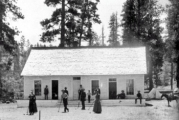 a fire of unknown cause completely destroyed the Bear Valley Hotel, and the resort business in Big Bear was wiped out overnight. After Gus Knight filed for bankruptcy, his brother-in-law, Charles Henry, rebuilt the hotel. In 1906, a group of wealthy investors from nearby Redlands purchased the new hotel, along with the surrounding 112 acres. Renamed "Pine Knot Lodge" and offering luxurious mountain accommodations, the lodge hosted many movie companies on location in the Valley until it closed in 1928.
a fire of unknown cause completely destroyed the Bear Valley Hotel, and the resort business in Big Bear was wiped out overnight. After Gus Knight filed for bankruptcy, his brother-in-law, Charles Henry, rebuilt the hotel. In 1906, a group of wealthy investors from nearby Redlands purchased the new hotel, along with the surrounding 112 acres. Renamed "Pine Knot Lodge" and offering luxurious mountain accommodations, the lodge hosted many movie companies on location in the Valley until it closed in 1928.
In 1906, Gus Knight inherited 40 acres east of Pine Knot Lodge and built Knights Camp, which he opened in 1915. This resort, located on the south shore of the lake, featured separate cabins, a central dining hall, dance hall, general store,
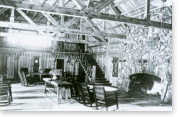 and a fleet of motor and row boats. Two years later, Albert Brush began construction of the Big Bear Lake Tavern. Brush's resort consisted of a main building, four large guest quarters, thirty separate cabins, employee quarters, lighting plant, garage and a stable. Soon after completion, the tavern was used as a film location site by a visiting movie company. The property still exists today but is now known as the Presbyterian Conference Center. In 1921, Carl and Mamie Stillwell opened the famous Stillwell's Lodge and Ballroom, located in a lakeside forest setting. It became known throughout Southern California
and a fleet of motor and row boats. Two years later, Albert Brush began construction of the Big Bear Lake Tavern. Brush's resort consisted of a main building, four large guest quarters, thirty separate cabins, employee quarters, lighting plant, garage and a stable. Soon after completion, the tavern was used as a film location site by a visiting movie company. The property still exists today but is now known as the Presbyterian Conference Center. In 1921, Carl and Mamie Stillwell opened the famous Stillwell's Lodge and Ballroom, located in a lakeside forest setting. It became known throughout Southern California
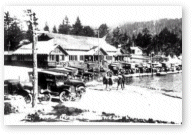 for good music and dancing. The lodge offered a beach, swimming pool, restaurant, tennis courts and boat landing. Soon it became a haven mountain retreat for young and old alike who, through the years, were entertained by top-name radio and recording bands. Motion picture companies often stayed here while on location, and its pavilion was used in several films. The same year that the Stillwell's opened their famous lodge, Emile C. Jesserun purchased 40 acres of Shay Ranch land, which included a natural hot spring that the Serrano Indians had used. Three years later, Jesserun opened the Pan Hot Springs Inn, one of the largest hotels in the valley. Its two large swimming pools, one indoor and one outdoor, ballroom, and medieval décor of hanging tapestries, suits of armor, swords and lances covering the walls made it an immediate success. Destroyed by fire in 1933, the resort was rebuilt with a smaller swimming pool, and continued to operate until it was damaged by an earthquake in 1992.
for good music and dancing. The lodge offered a beach, swimming pool, restaurant, tennis courts and boat landing. Soon it became a haven mountain retreat for young and old alike who, through the years, were entertained by top-name radio and recording bands. Motion picture companies often stayed here while on location, and its pavilion was used in several films. The same year that the Stillwell's opened their famous lodge, Emile C. Jesserun purchased 40 acres of Shay Ranch land, which included a natural hot spring that the Serrano Indians had used. Three years later, Jesserun opened the Pan Hot Springs Inn, one of the largest hotels in the valley. Its two large swimming pools, one indoor and one outdoor, ballroom, and medieval décor of hanging tapestries, suits of armor, swords and lances covering the walls made it an immediate success. Destroyed by fire in 1933, the resort was rebuilt with a smaller swimming pool, and continued to operate until it was damaged by an earthquake in 1992.
By 1924, Big Bear Lake had forty-four resorts in full operation, all supplied with electricity. Big Bear's tremendous popularity was never more evident than that year's Fourth of July, when approximately 10,000 cars loaded with tourists poured
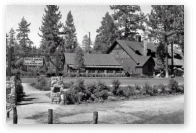 into the area. In 1925, Harry Kiener formed a corporation to develop mountain property in the valley area of Big Bear City, just east of the present-day airport. The Peter Pan Woodland Club was designed and built in 1930 by Guy Maltby, owner of the Bear Valley Milling and Lumber Company. The huge four-story clubhouse was surrounded by a golf course, beautiful landscaping, tennis courts, swimming pool, and gymnasium. Its symbol was a beautifully sculpted garden statue of Peter Pan sitting on an oversized mushroom. Many social events were held at the Peter Pan Clubhouse, and it soon became the heart of societal life in Big Bear City. A favorite site for film companies to stay while on location, the Clubhouse naturally appeared as a backdrop of several movies. For nearly twenty years, Peter Pan Woodland Club was both Big Bear's premier resort, as well as the foundation for the Big Bear City community that sprang up around it. When the Clubhouse was tragically reduced to ashes by an early morning fire on June 18, 1948, Big Bear lost one of its major landmarks.
into the area. In 1925, Harry Kiener formed a corporation to develop mountain property in the valley area of Big Bear City, just east of the present-day airport. The Peter Pan Woodland Club was designed and built in 1930 by Guy Maltby, owner of the Bear Valley Milling and Lumber Company. The huge four-story clubhouse was surrounded by a golf course, beautiful landscaping, tennis courts, swimming pool, and gymnasium. Its symbol was a beautifully sculpted garden statue of Peter Pan sitting on an oversized mushroom. Many social events were held at the Peter Pan Clubhouse, and it soon became the heart of societal life in Big Bear City. A favorite site for film companies to stay while on location, the Clubhouse naturally appeared as a backdrop of several movies. For nearly twenty years, Peter Pan Woodland Club was both Big Bear's premier resort, as well as the foundation for the Big Bear City community that sprang up around it. When the Clubhouse was tragically reduced to ashes by an early morning fire on June 18, 1948, Big Bear lost one of its major landmarks.
One of the oldest lodges in Big Bear Lake is the historic Oak Knoll Lodge, which dates back to September 1920 when Ernest G. Augustine and his wife Anna purchased a Valley cabin and its surrounding property. They built more cabins around the original one and named it Oak Knoll Lodge.
 Ideally located, Oak Knoll was the first lodge visitors saw upon entering Big Bear Valley when coming from Redlands via the Mill Creek and Clark Grade Roads. Across from the lodge on the Mill Creek Road was the upper control gate. In 1927, Oak Knoll Lodge was purchased by Roy and Elizabeth Lawrence. At the time, the cabins had no indoor plumbing. Eventually, Roy
developed a spring nearby and installed running water to each kitchen. Bathing was provided in the main building, with hot water for the showers supplied by a wood-fired water heating system. In the late 1930s, Oak Knoll became the first lodge to use butane gas for cooking. Roy Lawrence's son, Chuck, took over operation of the lodge in 1965. Three years later, Chuck married Christina, and their family still lives at and operates the lodge today. Located on National Forest Land, the rustic exteriors of the charming Oak Knoll Lodge cabins look much the same way as they did in the 1920s, but the insides have been upgraded with modern comforts.
Ideally located, Oak Knoll was the first lodge visitors saw upon entering Big Bear Valley when coming from Redlands via the Mill Creek and Clark Grade Roads. Across from the lodge on the Mill Creek Road was the upper control gate. In 1927, Oak Knoll Lodge was purchased by Roy and Elizabeth Lawrence. At the time, the cabins had no indoor plumbing. Eventually, Roy
developed a spring nearby and installed running water to each kitchen. Bathing was provided in the main building, with hot water for the showers supplied by a wood-fired water heating system. In the late 1930s, Oak Knoll became the first lodge to use butane gas for cooking. Roy Lawrence's son, Chuck, took over operation of the lodge in 1965. Three years later, Chuck married Christina, and their family still lives at and operates the lodge today. Located on National Forest Land, the rustic exteriors of the charming Oak Knoll Lodge cabins look much the same way as they did in the 1920s, but the insides have been upgraded with modern comforts.
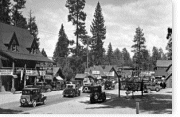 Although Big Bear Valley became a favorite summer mountain retreat for many, winter tourism was sparse because snow and mud rendered the dirt roads into the mountains impassable. In the mid-1920s, Walter E. Kruckman, the General Traffic Agent for the Motor Transit Company which served Crestline, Lake Arrowhead, Running Springs and the Big Bear Valley, sponsored radio spots to promote winter sports in Big Bear. Weather, road and snow conditions were telephoned to radio stations for broadcasting, while Los Angeles department stores featured ski clothes and equipment in their display windows. Sponsored by the Southern California Winter Sports League, Norway's ski champion, Sven Hansen, donated his time as a ski instructor at Big Bear.
Although Big Bear Valley became a favorite summer mountain retreat for many, winter tourism was sparse because snow and mud rendered the dirt roads into the mountains impassable. In the mid-1920s, Walter E. Kruckman, the General Traffic Agent for the Motor Transit Company which served Crestline, Lake Arrowhead, Running Springs and the Big Bear Valley, sponsored radio spots to promote winter sports in Big Bear. Weather, road and snow conditions were telephoned to radio stations for broadcasting, while Los Angeles department stores featured ski clothes and equipment in their display windows. Sponsored by the Southern California Winter Sports League, Norway's ski champion, Sven Hansen, donated his time as a ski instructor at Big Bear.
In 1929, the first ski jump in the mountains was built in Big Pines near Wrightwood, where a world ski jumping record was set. Similar ski jumps were built in Big Bear, and in the early 1930s, the Viking Ski Club of Los Angeles provided instruction and hosted ski jump competitions near today's Elk's Club.
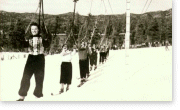 Carl Stillwell, the owner of the aforementioned Stillwell's Lodge and Ballroom, built a snow slide area and even promoted ice skating on Big Bear Lake, which was rather dangerous and is now illegal. Judge Clifford R. Lynn formed the Park District in 1934, and soon built a toboggan snow play area on the north facing slopes above the Big Bear Village. Meanwhile, downhill skiing was gaining popularity. In 1934, a sling lift was constructed at Fish Camp (present-day Snow Valley), and four years later the historic Lynn Sling Lift opened. Throughout the late 1930s and 1940s, Judge Lynn struggled to raise money for a chair lift. His efforts finally paid off in 1949 when construction was completed on the area's first 3,000-foot single chair lift, located behind Big Bear Village. Sadly, Judge Lynn died that same year without ever seeing his new lift in operation.
Carl Stillwell, the owner of the aforementioned Stillwell's Lodge and Ballroom, built a snow slide area and even promoted ice skating on Big Bear Lake, which was rather dangerous and is now illegal. Judge Clifford R. Lynn formed the Park District in 1934, and soon built a toboggan snow play area on the north facing slopes above the Big Bear Village. Meanwhile, downhill skiing was gaining popularity. In 1934, a sling lift was constructed at Fish Camp (present-day Snow Valley), and four years later the historic Lynn Sling Lift opened. Throughout the late 1930s and 1940s, Judge Lynn struggled to raise money for a chair lift. His efforts finally paid off in 1949 when construction was completed on the area's first 3,000-foot single chair lift, located behind Big Bear Village. Sadly, Judge Lynn died that same year without ever seeing his new lift in operation.
During the 1940s and early 1950s, several smaller ski areas using rope tows sprang up all over the north facing slopes of Big Bear Valley. These areas included an Upper and Lower Moonridge Rope Tow, located at the present-day base of Bear Mountain Ski Area.
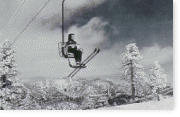 In 1947, during the midst of all of this activity, Tommy Tyndall, the man most responsible for popularizing skiing in this valley, arrived in Big Bear and started ski schools at several of the ski areas. He founded the Big Bear Winter Club and held the first Snow Carnival competition in 1949; however, Tyndall is primarily remembered as the man who built Snow Summit. Organizing a group of investors, and with financial assistance from his many friends, he created the Snow Summit Ski Corporation. In 1952, he opened Snow Summit with a one-mile long double chair lift, two major ski runs and several rope tows. This marked the beginning of Big Bear as a premier Southern California ski resort, and effectively changed it from a summer resort into a four-season resort. Unfortunately, the creation of Snow Summit coincided with several years of dry winters that lasted into the 1960s. These drought years would force the closure of most of the smaller ski areas and even threatened the existence of Snow Summit. In 1955, the Upper Moonridge Rope Tow experimented with snowmaking on a 300-foot run; it proved economically impractical, however, and was abandoned after two winters. In 1958, Chuck Smith installed snowmaking equipment on an 800-foot long rope tow ski area near Big Bear City called Rebel Ridge. Over the next three years, Smith proved that snowmaking was an economically viable solution during dry winters.
In 1947, during the midst of all of this activity, Tommy Tyndall, the man most responsible for popularizing skiing in this valley, arrived in Big Bear and started ski schools at several of the ski areas. He founded the Big Bear Winter Club and held the first Snow Carnival competition in 1949; however, Tyndall is primarily remembered as the man who built Snow Summit. Organizing a group of investors, and with financial assistance from his many friends, he created the Snow Summit Ski Corporation. In 1952, he opened Snow Summit with a one-mile long double chair lift, two major ski runs and several rope tows. This marked the beginning of Big Bear as a premier Southern California ski resort, and effectively changed it from a summer resort into a four-season resort. Unfortunately, the creation of Snow Summit coincided with several years of dry winters that lasted into the 1960s. These drought years would force the closure of most of the smaller ski areas and even threatened the existence of Snow Summit. In 1955, the Upper Moonridge Rope Tow experimented with snowmaking on a 300-foot run; it proved economically impractical, however, and was abandoned after two winters. In 1958, Chuck Smith installed snowmaking equipment on an 800-foot long rope tow ski area near Big Bear City called Rebel Ridge. Over the next three years, Smith proved that snowmaking was an economically viable solution during dry winters.
As the popularity of skiing grew rapidly during the 1970s and 1980s, Big Bear's winter tourism became more profitable than its summer tourism. Consequently, these two decades saw the development of two other ski areas, Goldmine and Snow Forest, as well as major improvements in snowmaking, ski runs, and chair lift capabilities at Snow Summit. In 1988, the Goldmine
ski area was purchased by S-K-I Ltd., a public corporation which also owned two large and successful ski areas in Vermont. The area was renamed Bear Mountain. Subsequent to the acquisition, millions of dollars were invested in the operating equipment, including the first high-speed chair lift in Big Bear Lake. Later, a high-speed chair lift was also installed at Snow Summit. Eventually, in 2002 the Snow Summit Ski Corporation acquired Bear Mountain, making it the owner of both resorts in Big Bear Lake.
In the late 1980s, snowboarding began sweeping across the country. Initially a sport exclusive to adolescent males, by the mid-1990s snowboarding had evolved into a sport enjoyed by all. Nowadays, families with children of all ages bring both skis and snowboards on their mountain vacations, while expert snowboarders from all over the world participate in exciting
international competitions. The enormous popularity of both skiing and snowboarding has completely transformed Big Bear Lake. In the span of just a few decades, what was once a summer resort that sat almost empty during the winter is now the destination of several million winter vacationers each year.
The beautiful scenery around Big Bear Lake has, through the years, attracted more than just sightseers, vacationers, and winter sports enthusiasts. By 1909, Los Angeles had become a mecca for the burgeoning movie industry. Fees imposed by Thomas Edison’s Motion Picture Patents Company (Edison Trust) had driven many
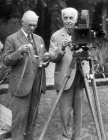 east coast independent filmmakers as far west as possible from Edison’s home base of New Jersey (see Los Angeles). With its warm climate and perpetually sunny weather, Southern California was ideal for filmmaking. During the early 1910s, theaters were beginning to appear in Redlands and San Bernardino showing the latest films from the moving picture companies of the day: Selig, Bison, Kalem, Pathé, Universal, Lasky, Edison, Lubin, Keystone, Biograph, Essanay and Vitagraph. Located just two hours from Los Angeles, Big Bear Lake was the area’s favorite mountain getaway and understandably attracted the budding movie industry. The magnificent tall trees, green meadows, and crystal clear lakes of
the San Bernardino Mountains beckoned these early filmmakers, and with the availability of several hunting and fishing lodges already established in the area, film crews had their choice of places to stay while on location. The first movie on record to be made in Big Bear was Thomas H. Ince's Little Dove's Romance (1911) by the Bison Company. This was followed by Apfel and DeMille's The Call of the North (1914) by the Lasky Company. In no time dozens of movies were being filmed in Big Bear Valley, and the area was soon nicknamed "Hollywood's backlot". Beginning in 1915, the list of films that have been produced in Big Bear Valley is impressive, as are the rosters of acclaimed directors who made them and actors who starred in them. Although just a sampling, the following enumerates some of these productions:
east coast independent filmmakers as far west as possible from Edison’s home base of New Jersey (see Los Angeles). With its warm climate and perpetually sunny weather, Southern California was ideal for filmmaking. During the early 1910s, theaters were beginning to appear in Redlands and San Bernardino showing the latest films from the moving picture companies of the day: Selig, Bison, Kalem, Pathé, Universal, Lasky, Edison, Lubin, Keystone, Biograph, Essanay and Vitagraph. Located just two hours from Los Angeles, Big Bear Lake was the area’s favorite mountain getaway and understandably attracted the budding movie industry. The magnificent tall trees, green meadows, and crystal clear lakes of
the San Bernardino Mountains beckoned these early filmmakers, and with the availability of several hunting and fishing lodges already established in the area, film crews had their choice of places to stay while on location. The first movie on record to be made in Big Bear was Thomas H. Ince's Little Dove's Romance (1911) by the Bison Company. This was followed by Apfel and DeMille's The Call of the North (1914) by the Lasky Company. In no time dozens of movies were being filmed in Big Bear Valley, and the area was soon nicknamed "Hollywood's backlot". Beginning in 1915, the list of films that have been produced in Big Bear Valley is impressive, as are the rosters of acclaimed directors who made them and actors who starred in them. Although just a sampling, the following enumerates some of these productions:
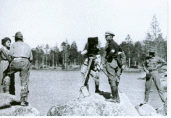 D.W. Griffith's The Birth of a Nation (1915) starring Henry B. Walthal and Lillian Gish; Rollin S. Sturgeon's The Chalice of Courage (1915) starring William Duncan; William Desmond Taylor's Davy Crockett (1916) starring Dustin Farnum; John Ford's A Fight for Love (1919) starring Harry Carey; Frederick Sullivan's The Courtship of Myles Standish (1923) starring Charles Ray; Allan Dwan's Heidi (1937) starring Shirley Temple; Henry Hathaway's Brigham Young - Frontiersman (1940) starring Tyrone Power and Shepherd of the Hills (1941) starring John Wayne; Raoul Walsh's High Sierra (1941) starring Humphrey Bogart; Fred Wilcox's Lassie Come Home (1943) starring Roddy McDowall; George Stevens' Shane (1953) starring Alan Ladd; Douglas Sirk's Magnificent Obsession (1954) starring Rock Hudson; Robert Stevenson's Old Yeller (1957) starring Fess Parker and The Love Bug (1969) starring Dean Jones; Gene Nelson's Kissin' Cousins (1964) starring Elvis Presley; Joshua Logan's Paint Your Wagon (1969) starring Lee Marvin; Howard Zieff's The Main Event (1979) starring Barbra Streisand; John Badham's WarGames (1983) starring Matthew Broderick; Arnold Schwarzenegger's Christmas in Connecticut (1992) starring Dyan Cannon; Rob Reiner's The American President (1995) starring Michael Douglas; Brad Silberling's City of Angels (1998) starring Nicolas Cage; Arlene Sanford's I'll Be Home for Christmas (1998) starring Jonathan Taylor Thomas; Michael Mann's The Insider (1999) starring Al Pacino; Paul Thomas Anderson's Magnolia (1999) starring Tom Cruise; and James Hickox's Sabretooth (2002) starring David Keith. In addition to being frequently seen on the big screen, Big Bear Valley has also been extensively used as a backdrop for such television productions as the Adventures of Wild Bill Hickok, Sergeant Preston of the Yukon, Bonanza, General Hospital, Daniel Boone, The F.B.I., The Fall Guy, Hill Street Blues, MacGyver, The Wonder Years, Rescue 911, The Trials of Rosie O'Neill, Party of Five, Sweet Valley High, and JAG.
D.W. Griffith's The Birth of a Nation (1915) starring Henry B. Walthal and Lillian Gish; Rollin S. Sturgeon's The Chalice of Courage (1915) starring William Duncan; William Desmond Taylor's Davy Crockett (1916) starring Dustin Farnum; John Ford's A Fight for Love (1919) starring Harry Carey; Frederick Sullivan's The Courtship of Myles Standish (1923) starring Charles Ray; Allan Dwan's Heidi (1937) starring Shirley Temple; Henry Hathaway's Brigham Young - Frontiersman (1940) starring Tyrone Power and Shepherd of the Hills (1941) starring John Wayne; Raoul Walsh's High Sierra (1941) starring Humphrey Bogart; Fred Wilcox's Lassie Come Home (1943) starring Roddy McDowall; George Stevens' Shane (1953) starring Alan Ladd; Douglas Sirk's Magnificent Obsession (1954) starring Rock Hudson; Robert Stevenson's Old Yeller (1957) starring Fess Parker and The Love Bug (1969) starring Dean Jones; Gene Nelson's Kissin' Cousins (1964) starring Elvis Presley; Joshua Logan's Paint Your Wagon (1969) starring Lee Marvin; Howard Zieff's The Main Event (1979) starring Barbra Streisand; John Badham's WarGames (1983) starring Matthew Broderick; Arnold Schwarzenegger's Christmas in Connecticut (1992) starring Dyan Cannon; Rob Reiner's The American President (1995) starring Michael Douglas; Brad Silberling's City of Angels (1998) starring Nicolas Cage; Arlene Sanford's I'll Be Home for Christmas (1998) starring Jonathan Taylor Thomas; Michael Mann's The Insider (1999) starring Al Pacino; Paul Thomas Anderson's Magnolia (1999) starring Tom Cruise; and James Hickox's Sabretooth (2002) starring David Keith. In addition to being frequently seen on the big screen, Big Bear Valley has also been extensively used as a backdrop for such television productions as the Adventures of Wild Bill Hickok, Sergeant Preston of the Yukon, Bonanza, General Hospital, Daniel Boone, The F.B.I., The Fall Guy, Hill Street Blues, MacGyver, The Wonder Years, Rescue 911, The Trials of Rosie O'Neill, Party of Five, Sweet Valley High, and JAG.
Beginning in the mid-1920s, story plots involving the Canadian Mounties were quite popular, and Big Bear's rugged wilderness, alpine lakes, high desert terrain and beautiful mountain vistas readily doubled for the Canadian Northwest landscape (see Cedar Lake). From early Silent to big budget Technicolor productions, with dozens of low-budget
B-pictures and action Serials in between, Big Bear was the perfect location for the silver screen Mounties to ride.
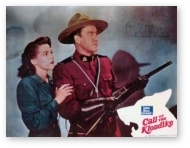 Silent Mountie flickers include Steele of the Royal Mounted Police (1925) starring Bert Lytell; Where the North Holds Sway (1927) starring Jack Perrin; and O'Malley Rides Alone (1930) starring Bob Custer. Many of the low-budget Mountie B-films were screen adaptations of stories written by the prolific novelist, James Oliver Curwood: Kermit
Maynard's Fighting Trooper (1934), Code of the Mounted (1935), His Fighting Blood (1935), Northern Frontier (1935), The Red Blood of Courage (1935), Trails of the Wild (1935), Wilderness Mail (1935), Phantom Patrol (1936), and Wildcat Trooper (1936); and Kirby Grant's Trail of the Yukon (1949), The Wolf Hunters (1949), Call of the Klondike (1950), Snow Dog (1950), Northwest Territory (1951), Yukon Manhunt (1951), Yukon Gold (1952), Fangs of the Arctic (1953), and Yukon Vengeance (1954). Other
Silent Mountie flickers include Steele of the Royal Mounted Police (1925) starring Bert Lytell; Where the North Holds Sway (1927) starring Jack Perrin; and O'Malley Rides Alone (1930) starring Bob Custer. Many of the low-budget Mountie B-films were screen adaptations of stories written by the prolific novelist, James Oliver Curwood: Kermit
Maynard's Fighting Trooper (1934), Code of the Mounted (1935), His Fighting Blood (1935), Northern Frontier (1935), The Red Blood of Courage (1935), Trails of the Wild (1935), Wilderness Mail (1935), Phantom Patrol (1936), and Wildcat Trooper (1936); and Kirby Grant's Trail of the Yukon (1949), The Wolf Hunters (1949), Call of the Klondike (1950), Snow Dog (1950), Northwest Territory (1951), Yukon Manhunt (1951), Yukon Gold (1952), Fangs of the Arctic (1953), and Yukon Vengeance (1954). Other
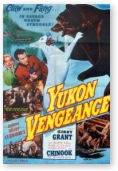 Mountie B-films made in Big Bear include Buck Jones' McKenna of the Mounted (1932); Tim McCoy's Fighting Shadows (1935); Dick Foran's Heart of the North (1938); Charles Starrett's Outpost of the Mounties (1939) and The Royal Mounted Patrol (1941); Bill Elliott's North of the Rockies (1942); Russell Hayden's Riders of
the Northwest Mounted (1943); and Gene Autry's Gene Autry and the Mounties (1951). From 1934 to 1936, Kermit Maynard had nine starring roles in a Northwest Mounties series, as did Kirby Grant from 1949 to 1954. In 1940, moviegoers saw Big Bear’s spectacular scenery in Cecil B. DeMille's bigger budget Technicolor Northwest Mounted Police starring
Gary Cooper and Madeleine Carroll. That same year also introduced several Mountie cliffhangers: Republic Pictures' 12-chapter serials King of the Royal Mounted (1940) and King of the Mounties (1942) both directed by William Witney and starring Allan Lane, Dangers of the Canadian Mounted (1948) directed by Fred Brannon and starring Jim Bannon, and Canadian Mounties vs. Atomic Invaders (1953) directed by Franklin Adreon and starring Bill Henry;
Mountie B-films made in Big Bear include Buck Jones' McKenna of the Mounted (1932); Tim McCoy's Fighting Shadows (1935); Dick Foran's Heart of the North (1938); Charles Starrett's Outpost of the Mounties (1939) and The Royal Mounted Patrol (1941); Bill Elliott's North of the Rockies (1942); Russell Hayden's Riders of
the Northwest Mounted (1943); and Gene Autry's Gene Autry and the Mounties (1951). From 1934 to 1936, Kermit Maynard had nine starring roles in a Northwest Mounties series, as did Kirby Grant from 1949 to 1954. In 1940, moviegoers saw Big Bear’s spectacular scenery in Cecil B. DeMille's bigger budget Technicolor Northwest Mounted Police starring
Gary Cooper and Madeleine Carroll. That same year also introduced several Mountie cliffhangers: Republic Pictures' 12-chapter serials King of the Royal Mounted (1940) and King of the Mounties (1942) both directed by William Witney and starring Allan Lane, Dangers of the Canadian Mounted (1948) directed by Fred Brannon and starring Jim Bannon, and Canadian Mounties vs. Atomic Invaders (1953) directed by Franklin Adreon and starring Bill Henry;
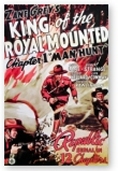 Universal Pictures' 13-chapter The Royal Mounted Rides Again (1945) directed by Ray Taylor and starring Bill Kennedy; and Columbia Pictures' 15-chapter Gunfighters of the Northwest (1953) starring Jock Mahoney and Perils of the Wilderness (1956) starring Dennis Moore, both directed by Spencer G. Bennet.
Universal Pictures' 13-chapter The Royal Mounted Rides Again (1945) directed by Ray Taylor and starring Bill Kennedy; and Columbia Pictures' 15-chapter Gunfighters of the Northwest (1953) starring Jock Mahoney and Perils of the Wilderness (1956) starring Dennis Moore, both directed by Spencer G. Bennet.
Big Bear Valley was also the backdrop in Republic Pictures' 12-chapter Western serial King of the Forest Rangers (1946) directed by Spencer G. Bennet and starring Larry Thompson. In addition, numerous other B-Western oaters were filmed in Big Bear, starring such icons as Bob Steele in Trailing North (1933), Grant Withers in The Test (1935), Larry "Buster" Crabbe in Nevada (1935) and Drift Fence (1936), George O'Brien in Daniel Boone (1936) and Park Avenue Logger (1937), Gilbert Roland in Thunder Trail (1937), William "Hopalong Cassidy" Boyd in Riders of the Timberline (1941), Roy Rogers in Don't Fence Me In (1945), North of the Great Divide (1950) and Trail of Robin Hood (1950), Gene Autry in Riders of the Whistling Pines (1949) and Blue Canadian Rockies (1952), and Rex Allen in Border Saddlemates (1952) and Colorado Sundown (1952). It has been decades since the genres of B-Westerns and serial cliffhangers captivated audiences, and that era is long gone; but thanks to videos and DVDs, the movies themselves, which often featured the spectacular scenery of Big Bear Valley, will never be forgotten.
Today, Big Bear Valley is more popular than it ever was. The area continues to be used as a film location for many Hollywood productions, and people from all over the world flock here to enjoy clean air, blue skies and year-round activities. In winter, Big Bear offers skiing, snow boarding, snow-shoeing, sledding, ice skating and ice hockey, while summer vacationers enjoy boating, sailing, water skiing, fishing, parasailing, swimming, hiking, camping, mountain biking, horseback riding, and golfing. The Valley is also the home of the Big Bear Museum and Big Bear Valley Historical Society, some of whose photographs have been highlighted in this article. Run by members and volunteers of the non-profit Historical Society, the Museum houses important artifacts and landmarks pertaining to Big Bear Valley and is a must-see for any visitor to the area. Big Bear Lake is also host to a variety of entertaining events throughout the year including Old Miner's Days, Oktoberfest, mountain bike racing, hobie cat regattas, jazz festivals, car shows, trout classics, rodeos, and ski and snowboard competitions. Anytime of year, whatever your interest, you are sure to find fun and excitement in Big Bear Valley.